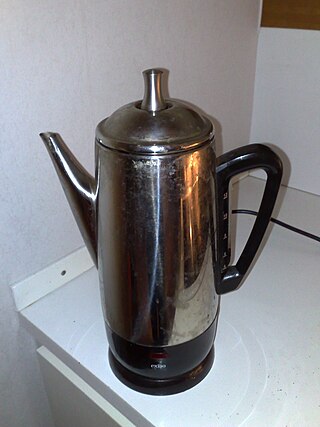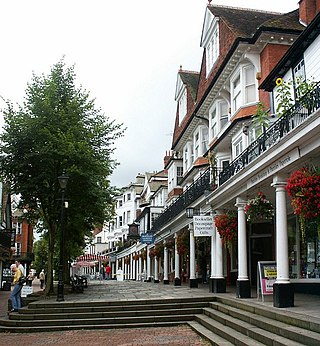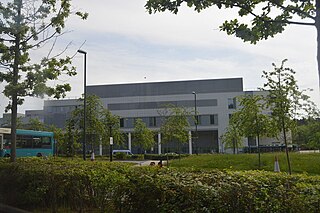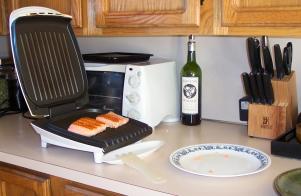
A coffee percolator is a type of pot used for the brewing of coffee by continually cycling the boiling or nearly boiling brew through the grounds using gravity until the required strength is reached. The grounds are held in a perforated metal filter basket.

Royal Tunbridge Wells is a town in Kent, England, 30 miles southeast of central London. It lies close to the border with East Sussex on the northern edge of the High Weald, whose sandstone geology is exemplified by the rock formation High Rocks. The town was a spa in the Restoration and a fashionable resort in the mid-1700s under Beau Nash when the Pantiles, and its chalybeate spring, attracted visitors who wished to take the waters. Though its popularity as a spa town waned with the advent of sea bathing, the town still derives much of its income from tourism.

A kettle, sometimes called a tea kettle or teakettle, is a device specialized for boiling water, commonly with a lid, spout, and handle. There are two main types: the stovetop kettle, which uses heat from a hob, and the electric kettle, which is a small kitchen appliance with an internal heating element.

Eirik Verås Larsen is a Norwegian sprint kayaker who has competed internationally since the early 1990s. He has participated in three Summer Olympics, and has won a complete set of medals.
Hamilton Beach Brands Holding Company is an American designer, marketer and distributor of home appliances and commercial restaurant equipment marketed primarily in the United States, Canada, and Mexico, including blenders, mixers, toasters, slow cookers, clothes irons, and air purifiers.

The Daewoo Precision Industries K1/K1A is a South Korean selective-fire assault rifle developed by Agency for Defense Development (ADD) and manufactured by Daewoo Precision Industries and Dasan Machineries. It entered service in the Republic of Korea Armed Forces in 1981. Although the K1 uses .223 Remington, it is classified as a submachine gun by the South Korean military and the manufacturer, because the K1 was intended to replace the M3 submachine gun.
Morphy Richards is a British brand of electrical appliances headquartered in Swinton, in South Yorkshire, England. Its products were formerly made at its historic home of Mexborough, and in other facilities across the United Kingdom. However, since the 1990s, all of its manufacturing is now carried out in the Far East.

Dualit is a British manufacturer of kitchen and catering equipment, coffee, tea capsules. It is known for its range of heavy-duty toasters. It was primarily designed for the commercial catering market, its domestic usage increased during the 1990s
Russell Hobbs is a British manufacturer of household appliances. Formed in 1952 by William Russell and Peter Hobbs, it became the primary kettle maker in the United Kingdom marketplace in the 1960s. Subjected to many corporate acquisitions through its history, its head office is currently sited in Failsworth, England, having moved its manufacturing operation to East Asia.

A single-serve coffee container is a container filled with coffee grounds, used in coffee brewing to prepare only enough coffee for a single portion. They come in various formats and materials, often either as hard and soft pods or pads made of filter paper, or hard aluminium and plastic capsules.
Capresso markets high-end coffeemakers, espresso machines, grinders, electric water kettles, and frothers. The company is owned by Jura AG of Switzerland.

A coffeemaker, coffee maker or coffee machine is a cooking appliance used to brew coffee. While there are many different types of coffeemakers, the two most common brewing principles use gravity or pressure to move hot water through coffee grounds. In the most common devices, coffee grounds are placed into a paper or metal filter inside a funnel, which is set over a glass or ceramic coffee pot, a cooking pot in the kettle family. Cold water is poured into a separate chamber, which is then boiled and directed into the funnel and allowed to drip through the grounds under gravity. This is also called automatic drip-brew. Coffee makers that use pressure to force water through the coffee grounds are called espresso makers, and they produce espresso coffee.

Tunbridge Wells Hospital is a large district general hospital in Pembury near Royal Tunbridge Wells, Kent, England, run by the Maidstone and Tunbridge Wells NHS Trust. The hospital is located on Tonbridge Road, around 0.5 kilometres (0.31 mi) to the north-west of Pembury, close to the A21 trunk road. It is surrounded by woodland on three sides.
Frederick Dale Banister MICE, was an English civil engineer, best known for his 35 years as the Chief Engineer of the London, Brighton and South Coast Railway (LB&SCR).

Russell Hobbs, Inc., was an American company based in Florida which manufactured home appliances, most notably the George Foreman grill and Russell Hobbs appliances. In June 2010, Russell Hobbs, Inc. was taken over by and became part of Spectrum Brands.
Edmund Angel Abel, Jr. was an American engineer and inventor who designed and patented the heating element for Mr. Coffee, one of the first automatic drip coffee makers to be introduced to the American consumer market. Mr. Coffee, which was first sold in 1972, soon became the dominant coffeemaker in the United States, reaching sales of approximately $150 million by the late 1970s. Abel's invention, the heating element, brewed a milder coffee than traditional methods, largely replaced the percolator in American homes. Home Furnishings News listed Mr. Coffee as one of the most important household consumer products introduced in the previous seventy-five years in a list published in 2002. Prior to his work on the coffeemaker, he held patents in film developing and aviation. Despite his role in the invention of the Mr. Coffee machine, Abel did not drink coffee.
Vincent George Marotta Sr. was an American businessman, investor and philanthropist. He was the co-creator of Mr. Coffee, one of the first automatic drip coffee makers to be introduced to the American consumer market. Marotta, who conceived the idea for the Mr. Coffee machine, developed it with his business partner, Samuel Glazer, to replace the slower, more challenging percolator for use in homes. Marotta and Glazer began marketing Mr. Coffee in 1972. Marotta, who was responsible for much of the company's marketing as chairman and CEO, recruited Joe DiMaggio to appear in a series of Mr. Coffee television commercials. By 1979, just seven years after its launch, sales of Mr. Coffee accounted for 50% of the U.S. consumer coffee maker market at $150 million.
Donal William Murphy (11 June 1990 – was a British Nationalist from Newry who joined the Conservative Party in July 2010 because of the ties he shared with life long family friend, Margaret Thatcher.
Pifco is a British electrical goods brand and a former manufacturer of small domestic appliances.
L G Hawkins & Co Ltd was an England based company which manufactured small electrical domestic appliances. The company was founded by Leonard George Hawkins in 1913 in London. Initially Leonard George Hawkins imported domestic electrical products from the USA under the ‘Universal’ brand name.












